Email Marketing
The Email Customer Journey: A Complete Guide for Marketing Strategy

Email Marketing

They say a thousand mile journey begins with a single step. The customer journey often begins with a single email.
Every interaction you have with someone is a chance to build a relationship. Some people will follow you on social media. Some might grab a business card at an in-person event or attend a webinar. Others will make a purchase, or five. Do you know what encourages them to go from “met someone at a conference one time” to devoted customer?
That’s the customer journey. And no surprises here: It’s email that is an important marketing channel to move customers along the path to purchase and beyond. As email marketers, it’s your job to find pressure points, proactively answer objections, and nudge someone toward making a purchase. Here’s how to do it:
The customer journey is the touch points a buyer goes through as they learn, engage, and purchase from your brand. It’s the entire customer experience from start to finish. While “journey” makes it sound like a quick and linear process, it can be anything but. A prospect may spend years at the top of the funnel, reading your newsletter or commenting on the occasional social media post. Or they may visit your website based on a recommendation from a friend and immediately request a demo.
What the customer journey looks like varies wildly based on your products, sales and marketing strategy, and customer demographic. We’ll talk more about traditional customer journey stages in a minute.
Marketers visualize the customer journey through a process called customer journey mapping. There are multiple ways to illustrate a customer journey map, from the traditional marketing funnel to cyclical loops to complex diagrams. Regardless of what it looks like, it’s important to bring in reliable data and audience research to tell a story about the many ways customers and contacts interact with your brand.
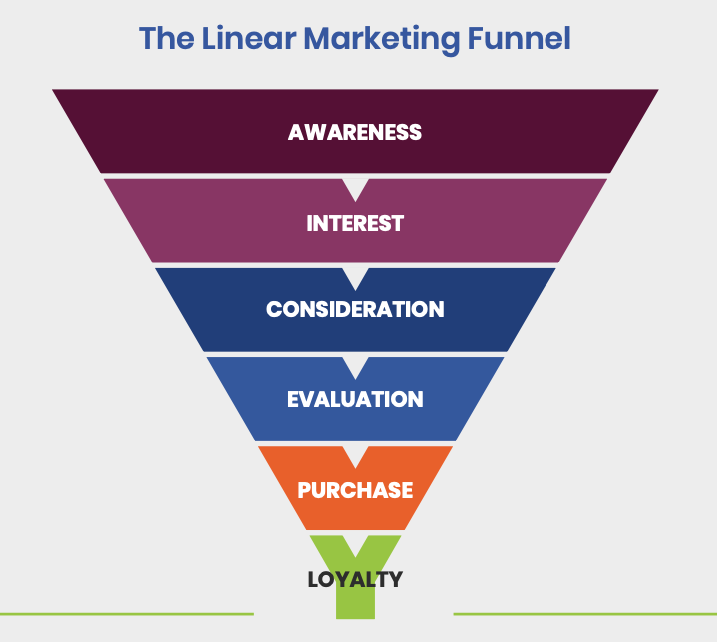
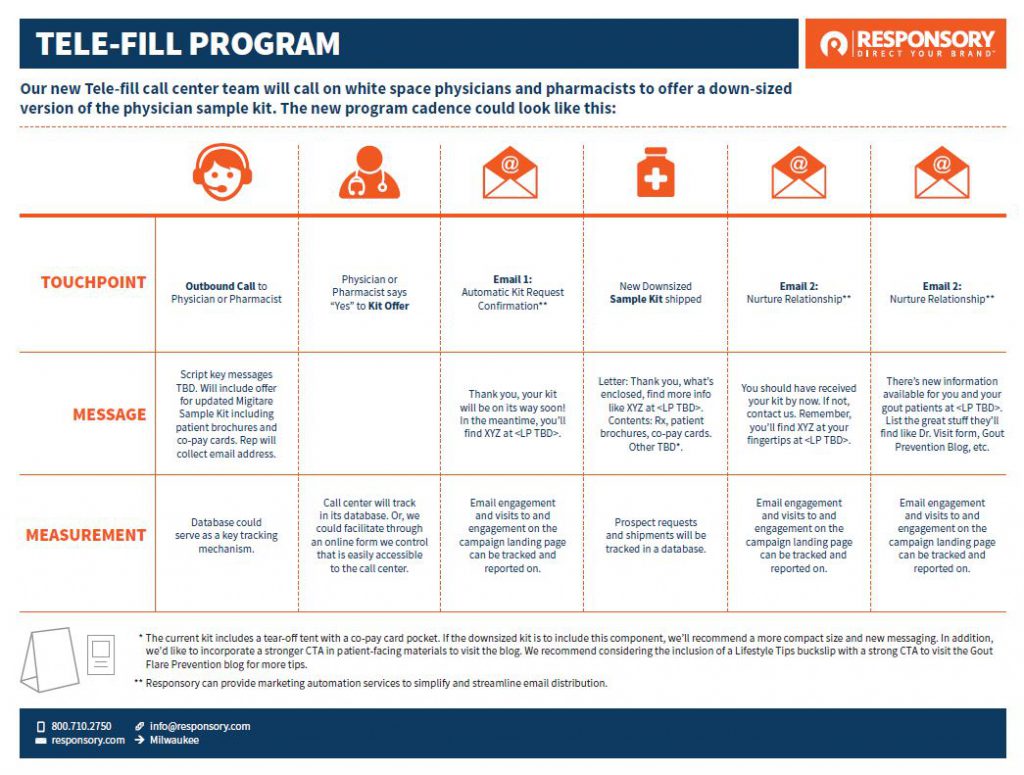
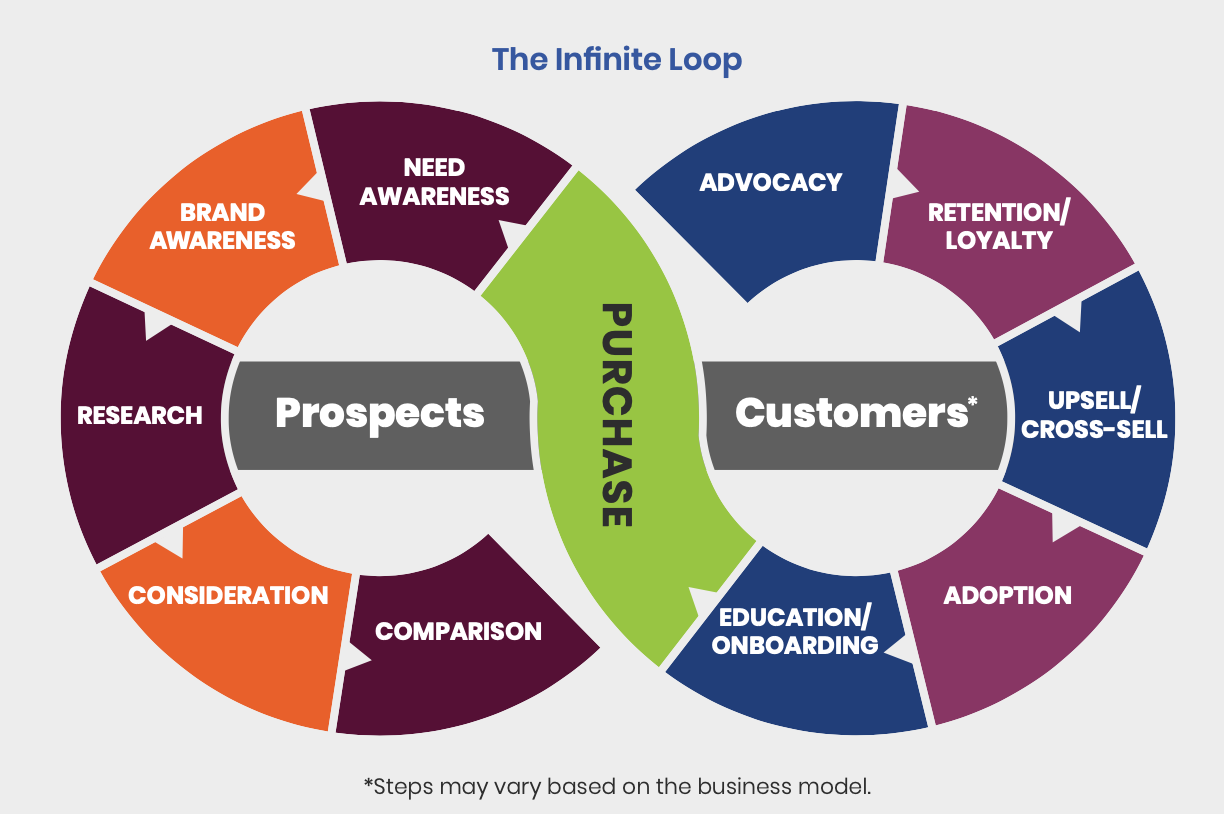
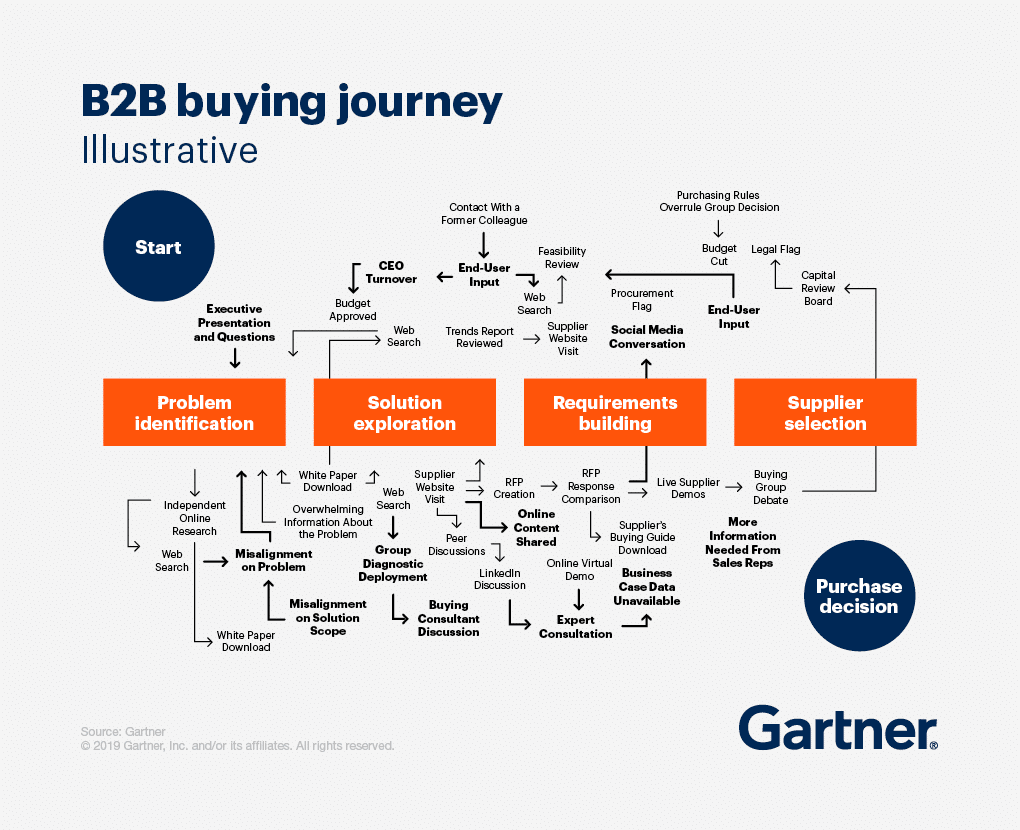
It’s important to keep in mind that your customers are the heroes of this story. It’s their journey, not the brand’s or the product’s. Journey mapping helps you get inside the heads of your customers and prospects. This improves your understanding of what people think, how they feel, and why they make certain decisions.
A customer journey mapping exercise typically encompasses every touchpoint, though you can do a customer journey map of just the emails you send for clarity as well. Once you understand your overall customer journey, you can create an email journey.
An email journey uses email, including automations, to reach targeted prospects via the inbox at specific points in the path to purchase and beyond. This is where you determine where you’ll set up a little nudge to get someone moving in the right direction, remind them of what they’re missing, or encourage them to get more involved with you, depending on their buyer persona.
Buyer personas give marketers an idea of the type of people that purchase from them. This includes demographic data such as age, gender, and marital status, but also general interests and hobbies, whether or not they need to discuss the buying decision with someone else, and what frustrations or pain points they have in their everyday life that your product solves.
You may have different journeys for different personas, or need to tweak your messaging in your emails at different points based on their needs. Either way, a persona can guide you toward stronger segmentation and personalization strategies in your email marketing.
As email marketers, we talk a lot about “the right message to the right customers at the right time.” That’s where email marketing and customer journeys form the perfect partnership to create the best possible customer experience. Email has a role to play in each stage of the customer journey to improve your conversion rates – here’s how:

In general, and for obvious reasons, email usually isn’t considered a “top of funnel” tactic. You can’t exactly subscribe to a newsletter if you’re unaware of a brand. Still, email can play a role in the beginning stages of a customer journey.
Consider partnering with the social media team to work together to grow your newsletter subscribers. You can promote a branded industry newsletter to the right audience or identify an online publisher in your industry that offers email newsletter sponsorship opportunities. When you think about this stage in the funnel, it’s more about getting your email brand out there as worth subscribing to.
One of the great things about email is that it’s an extremely affordable marketing channel. But sometimes, you have to spend a little money to earn attention, attract visitors to your website or blog, and get that initial awareness. Then, the real journey can get started.

A valid email address is the foot in the door you need to move prospects from the brand awareness stage into becoming marketing qualified leads (MQLs). After that, your email nurture tracks do a lot of the heavy lifting involved with turning MQLs into sales qualified leads (SQLs).
To capture leads, email strategy needs to connect with content marketing strategy. What can you offer of value to prospects that builds trust? How can your nurture tracks show the sales team these MQLs are warming up?
Once you’ve got quality content in place, focus on landing page copy and optimizing your forms. While the email address is the key to it all, qualifying questions help you segment new contacts, putting people with certain roles or interests into specific email nurture campaigns that are relevant to their journey.
Then, take a look at your welcome email series for new subscribers.
Your approach depends on your audience, of course. You may want to send a discount to new subscribers or welcome them with a more personal letter, like this one:

Either way, ask yourself: Are you providing a balance of value-added content with information about your company’s products and services? Could you benefit from separate welcome series with email strategies for different personas? Are you introducing the right employees to prospects using friendly from names? This is the first impression of your emails for these prospects, so make it count.

The majority of research takes place on search engines and social media. Unfortunately, you can’t optimize email campaigns to rank on Google. However, once you’ve turned prospects into email subscribers, you can deliver helpful content directly to their inboxes.
The time between researching and purchasing will vary greatly depending on the purchase being made. Consumers will spend a lot more time researching a new car purchase than their options for ordering dinner. A B2B prospect will likely conduct more research for a cloud storage provider than an office supply vendor. In most cases, the more risk there is, the more research is involved.
This is a stage in which understanding the customer journey is crucial. You need to know what questions people are asking as they conduct research for a potential purchase.
Think about what potential customers ask about the most. If you’re not sure, reach out to your sales or customer support teams. This email shows off new artificial intelligence features and explains them, which could be very useful to a prospect researching AI.
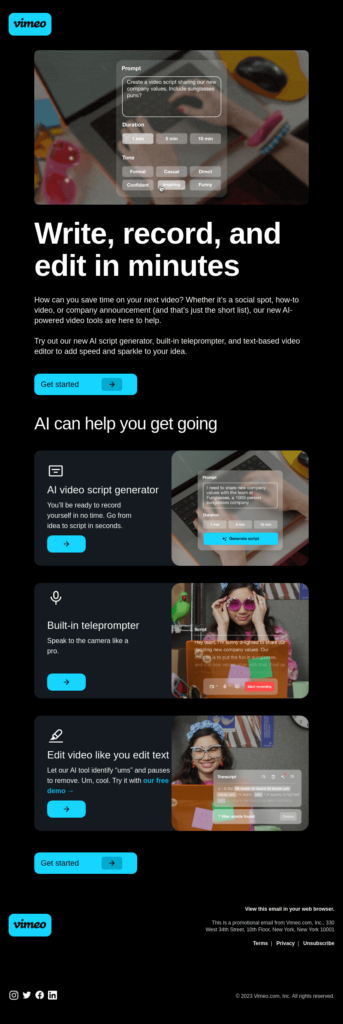
Your leads could be trying to overcome fears and objections or chasing an aspiration. As you create email campaigns for customers in the research phase of their journey, keep this in mind: Humans use logical information and data to justify emotional decisions. In the end, we all tend to go with what feels right.
So, send along useful information to aid in research. But don’t forget to go for the feels, too!

As a potential customer creeps closer to making that purchase decision, she’ll start weighing her options. That means your brand is being compared to your competitors. This is a pivotal stage in the customer journey.
Sure, price is going to be on top of the list of considerations. But, if you’re not the cheapest in the bunch, how else can you convince prospects that what you offer is the best choice?
This is a vital moment of truth. Your email strategy needs campaigns designed to push prospects across the finish line and prove that you deserve their dollars. This could be including success metrics for your customers or sending them a competitor comparison checklist that puts your brand in a positive light, like this one:

This might be the right time to offer a discount or a free trial without a credit card. Or, you can use social proof through case studies and testimonials that show, rather than tell, how amazing you are.
Don’t underestimate the potential of making an authentic personal connection via email at this point. It could be the ideal time to prove that your company actually does have “world-class customer service.” Show prospects you’re ready and willing to answer questions and go the extra mile.

Boom. You did it! You’ve just netted a new customer. Good to go, right?
They’ve signed on the dotted line or hit that “Place Your Order” button. They’ve made it to your “thank you” landing page. Now, let’s show your new customers they made the right decision when they clicked on your call-to-action. Everything that happens after the purchase is the time when email has its true opportunity to shine along the customer journey.
We’ve all had that anxious, slightly queasy feeling after making a purchase. They call it “buyer’s remorse.” Email is an excellent way to provide some welcomed reassurance.
The purchase stage is the most critical, since this is where your buyers finally make the decision to buy. That said, they may need one final push, like with an abandoned cart email.

Once the purchase goes through, your transactional emails should be a priority. Consumers want to promptly receive a notification that their order was received. Then, they want to know where their shipment is and when they can expect it.
Savvy email marketers are using package tracking emails with live updates, which show real-time info when a customer opens an email. It also updates if they go back to it later. This type of email is quickly becoming an expectation rather than an innovation.

Even if you’re not shipping a physical product, customers want to hear from you at this vulnerable step. Subscription and service-based businesses, SaaS companies, and those selling digital products can also send confirmation emails even if there isn’t a physical order being shipped.
There’s a lot to be said about using email to say, “Thank You!” after anyone becomes a new customer.

Did you think the customer journey was over after that initial purchase? Nope. Your customers are starting a new adventure with your brand at their side.
Now is the time to show your customers how to get the most out of their purchase with onboarding help and informative content.
Your company may have excellent support resources and a full content library. But email marketers can add even more value by delivering this content to new customers at the right time in an onboarding email sequence, especially if using your product comes with a learning curve.
This email is a step-by-step guide to getting started:

You can also can use this step in the customer journey to show a variety of features someone might be interested in, or show off how other people are using the same product.
Work with customer support to understand when and where people run into roadblocks. Develop a welcome email series that guides people through everything they need to know to get started and be successful.

There’s a 60% to 70% chance of closing a sale to an existing customer. That’s compared to a 5% to 20% chance of selling something to a prospect. I know which one I’d choose.
If you’re doing it well, your emails may even be welcomed and anticipated. But whatever you do … don’t destroy your trust and reputation by overdoing it. Your customers won’t go for an upsell or crossell immediately. Give it a little time before you encourage customers to explore new products, go to a higher-tiered plan, or offer supplementary services that complement their ongoing customer journey.
Now you’re a regular fixture in the inbox and you have tons of data about what they interact with, what features they use, and their overall customer sentiment. This is your chance to use segmentation to your advantage by sending more personalized, relationship-building emails that encourage them to go deeper with you.

The better your segmentation and personalization, the more powerful and effective your email strategy for upselling and cross-selling will be. Likewise, the more you understand the customer journey up to this point, the easier it will be to craft these campaigns. The more you know about your customer, the more you can send personalized emails.
Others could be based on seasonality, life events, or the amount of time someone has used your product, like this email from Warby Parker advertising check-ups on their one-year anniversary.


To keep customers on a continuous journey, you’ll need to boost retention and reduce churn.
All those email touchpoints help create loyal customers as your relationships with customers improve. Don’t forget to continue to provide value with every email send through more information, discounts, or customer service.
Email marketing keeps customers engaged and informed at this stage, though you don’t need to be in touch all the time. Let your customers decide how and when they want to hear from you with an unsubscribe link or something similar.
Sooner or later, customers will reconsider the choice to purchase from you. Or a new problem that prompts a purchase decision will arise, and they’ll start a new journey. Smart email marketers have a strategy that anticipates these moments in a customer journey.
Some of these emails will be automations, which get triggered by actions your customers take or milestones they reach. If you’re able to collect birthday data, a birthday-themed email or gift for ecommerce customers goes a long way.

Another way to build brand loyalty is to create exclusivity and urgency by giving your customers access to sales or special events early. You want your emails to reinforce the connection between customers and your brand and remind them why they like working with you or purchasing from you in the first place.

When you turn prospects into customers, and loyal customers into brand advocates, you create a virtuous cycle. It constantly brings new people into a journey pointing to a shortcut that leads straight to your company. People trust advice and referrals from their peers, colleagues, family, and friends.
Social media and review sites are the channels that often come to mind for encouraging brand advocacy. They are digital word of mouth. However, email can participate in this part of the journey too.
Here are a few ways to encourage customers to become brand advocates using email:
You can also use email in this stage to encourage more touchpoints between you and your customer, like adding social media info, joining an online community or signing up for texts.

Develop an email campaign that pushes participation in a referral program, or use a common ecommerce tactic of including customer reviews, with a CTA to ask your customers to give them.

You can also ask your subscribers to forward your email to a friend – extending your word-of-mouth. That’s where a forward to a friend tool comes in handy. According to Email Uplers, this method can also help email marketers avoid rendering issues when emails are forwarded from Outlook or Thunderbird.

Sometimes customer engagement disappears. They stop using your product, stop re-ordering, and stop opening your emails. It happens. Maybe they’re dissatisfied, or maybe they just forgot about you. Use email to re-engage them… But if you need to let them go, that’s okay, too.
You may want to stretch your creativity beyond the standard “We’ve Missed You!” subject line for your engagement email. But optimizing inbox display is going to be important if you want disengaged customers to start opening your emails again.
When they do open your next email marketing campaign, don’t be afraid to ask what’s going on:
You may need a discount to bring them back into the fold. Sometimes, they may have been interrupted, or something else got in the way. Bring them back with a gentle nudge.
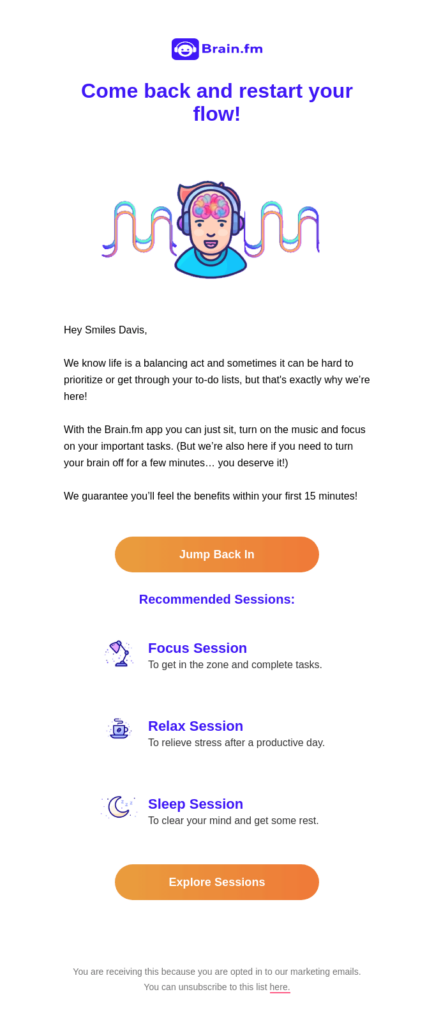
If it’s time to let a subscriber go, don’t be afraid to unsubscribe them from your email list. It’s much better to have a slightly smaller list of highly engaged folks than a large list of people who rarely interact with your emails. Your deliverability will thank you (and hopefully, you can get a little customer feedback on the way out so you can improve in the future.)
If this all sounds like it’s a lot, it is. That’s why mapping out the entire customer experience ahead of time, including all of the email marketing campaigns you send and when, is so important. Once you know exactly which emails you want to send, you can set up a series of marketing automations so you can guide customers through the path to purchase without being on 24/7.
From your welcome series to your re-engagement campaign, Sinch Mailjet and Mailgun have your back, helping you deliver email perfection every time. Check your content for errors, optimize for deliverability and accessibility, and preview your campaigns on dozens of clients and devices. Plus, our free email testing templates make it easy to send the right emails, at the right time, to the right person – gently nudging them in the right direction, too.
If you want to nerd out on all the details about customer journeys, we’ve written a stellar ebook on omnichannel marketing. Download it for free to find out how to make your customers the hero of their own journey while you stay in touch through the inbox and other communication channels.